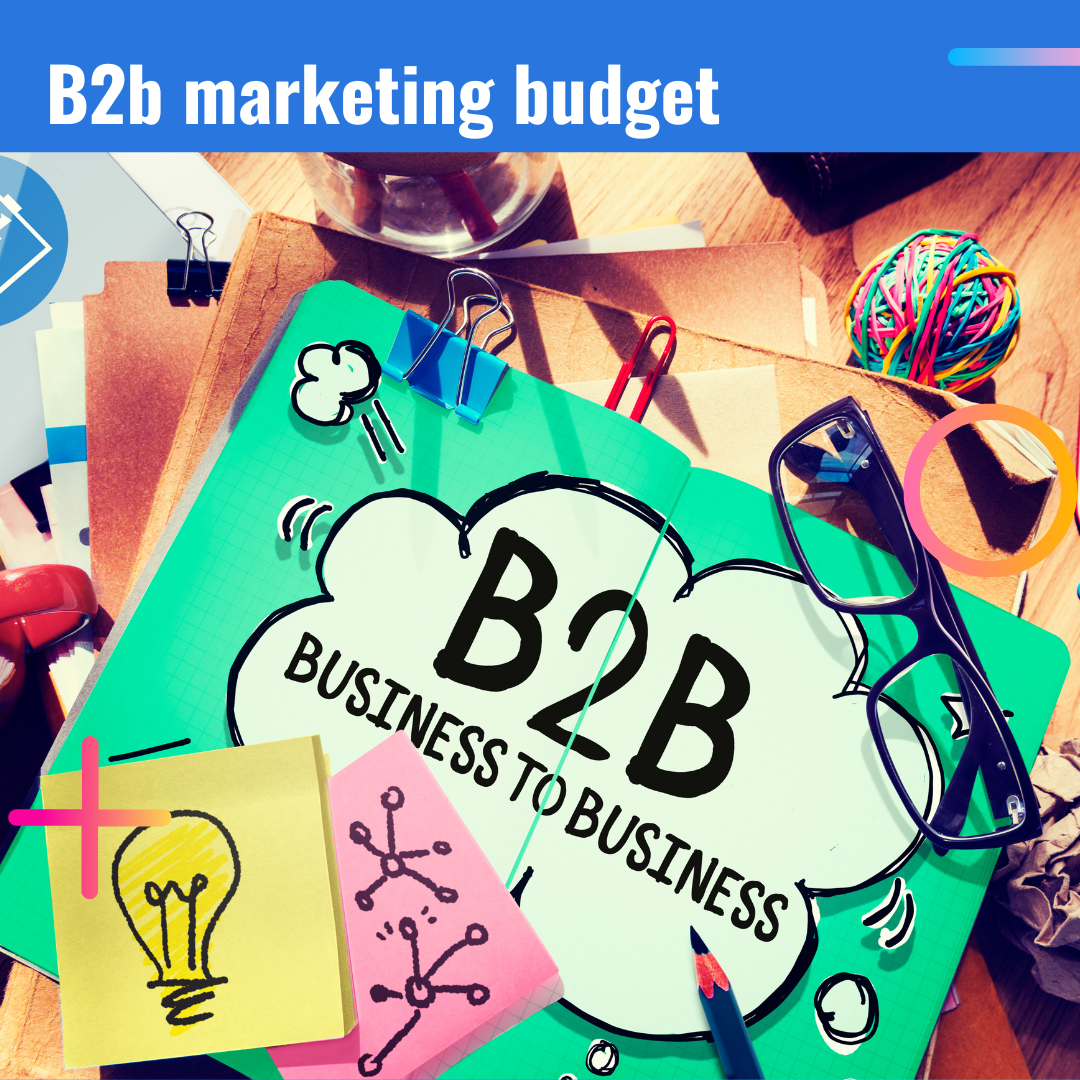The budget for B2B marketing can vary greatly depending on the company and industry. Some companies may have a small budget dedicated to B2B marketing, while others may have a larger budget. Factors that can influence a B2B marketing budget include:

- The size of the target market.
- The cost of marketing materials and campaigns.
- The overall financial resources of the company.
What is b2b marketing?
B2B (business-to-business) marketing refers to a company’s strategies, tactics, and techniques to promote businesses or organizations.
IN B2B digital marketing, consider the specific goals and objectives of the campaign, as well as the target audience.
Some common digital marketing tactics that businesses may use include:
- Search engine optimization (SEO)
- Pay-per-click (PPC) advertising
- Content marketing
- Social media marketing
- Email marketing
- Webinars and other online events
How to Allocate B2B Digital Marketing Budget What percentage of revenue should you allocate to marketing?
The percentage of revenue that a business should allocate to marketing can vary greatly depending on the industry and company. According to the Gartner CMO Spend Survey.
Your Goals
Defining your goals is essential in allocating a budget for B2B digital marketing. Goals are specific, measurable, and time-bound objectives that a business wants to achieve through its marketing efforts.

With clear goals, it can be easier to determine the success of a marketing campaign and allocate the budget effectively.
Defining your goals is essential to consider both short-term and long-term objectives. Some examples of common goals for B2B digital marketing include:
- Increasing website traffic
- Generating leads
- Improving brand awareness
- Boosting sales
- Enhancing customer engagement
Establishing key performance indicators (KPIs) for each goal is also essential to measure progress and success. These KPIs should be specific, measurable, and aligned with the campaign’s goals.
Defining your goals is crucial to understanding what you want to achieve and allocating your budget. It also helps to measure the success of the campaign.
Are there emerging or growing competitors?
Yes, there can be emerging or growing competitors in any industry. It’s essential to stay aware of the competitive landscape to effectively allocate a budget for B2B digital marketing. Here are a few things to consider when evaluating the presence of emerging or growing competitors:

- Research your competitors:
- Monitor industry trends:
- Look for new entrants:
- Analyze their online presence:
What are the most significant opportunities in your industry?
The most significant opportunities in an industry will vary depending on the specific industry and market conditions. It’s essential to conduct research and stay up to date & developments in your industry to identify potential opportunities.
Analyze your target market:
Understand your target market’s needs, wants, and pain points, as well as their buying habits and decision-making processes. This will help you identify potential opportunities for new products or services.
Look for new technologies:
Stay informed about technological advancements that could disrupt your industry. This can create new opportunities for businesses that can adapt and take advantage of these new developments.
Identify trends:
Look for emerging trends in your industry, such as changes in consumer behavior, shifts in regulations, or new business models. These trends indicate new opportunities for growth and expansion.
Study your competitors: Analyze your competitors’ products, services, marketing strategies, and customer feedback.
Analyze the market:
Look at the size and growth potential of the market, as well as market segments that are underserved or underrepresented. This can help you identify potential opportunities for growth and expansion.
Are their new products/services to highlight?

B2B digital marketing can generate interest and drive sales. Here are a few things to consider when evaluating new products or services to highlight:
Evaluate product/service:
your new product or service, and determine how they compare to existing products or services in the market.
Study your competitors:
Analyze your products and services, and determine how your new product or service compares.
Look at your budget:
Determine the budget for marketing the new product or service, and allocate the budget to different channels accordingly.
How effective is your website at converting leads?
Evaluating the effectiveness of your website at converting leads is an essential step in determining how to allocate your B2B digital marketing budget.
Here are a few things to consider when assessing the performance of your website in converting leads:
Analyze website traffic:
This will give you an idea of how well your website is performing in terms of attracting visitors.
Measure conversion rates:
Track the number of visitors who take a specific action, such as filling out a form or making a purchase. This will give you an idea of how well your website converts visitors into leads.
Analyze visitor behavior:
Use heatmap and click-tracking tools to understand how visitors interact with your website. you insight into where visitors are dropping off and which elements of your website may be causing friction.
Test and optimize:
Use A/B testing and other optimization techniques to test different website elements and determine the most effective at converting leads.
Look at customer feedback:
Look at customer feedback and testimonials, and conduct surveys to understand how visitors feel about your website.
What’s new/emerging in your industry?
Evaluating new and emerging trends in your industry can help you stay ahead of the competition and make informed decisions about how to allocate your B2B digital marketing budget.
- Monitor industry news and publications: Keep an eye on industry news and publications, such as trade journals and websites, to stay informed about new developments and trends.
- Follow influencers and thought leaders: Follow influencers and thought leaders in your industry on social media and sign up for their newsletters to stay informed about new and emerging trends.
- Attend industry events: Attend industry events, such as trade shows and conferences, to stay informed about new developments and trends and to network with other professionals in your industry.
- Participate in online communities: Participate in online communities, such as forums and LinkedIn groups, to stay informed about new and emerging trends and connect with other industry professionals.
- Look at your competitors: Analyze your competitors’ marketing strategies, and see what they’re doing in terms of new and emerging trends.
What is your monthly target for qualified leads?
Setting a monthly target for qualified leads is essential in determining how to allocate your B2B digital marketing budget. Qualified leads are potential customers who have shown interest in your products or services and have met specific criteria that make them more likely to convert into paying customers. Here are a few steps you can take to set a monthly target for qualified leads:
- Understand your ideal customer: Understand your ideal customer by creating a buyer persona, a popular fictional representation of your ideal customer based on market data.
- Estimate your lead-to-customer conversion rate: Estimate your lead-to-customer conversion rate by looking at past data on how many leads you’ve generated and how many of them have converted into paying customers.
- Determine your monthly revenue goal: Determine your monthly revenue goal, and divide that number by your lead-to-customer conversion rate to calculate the number of qualified leads you need to generate to reach your goal.
- Set a monthly target: Set a monthly target for the number of qualified leads you need to generate to reach your revenue goal.
- Track and adjust: Track your progress towards your monthly target for qualified leads, and adjust your marketing strategy as necessary to ensure you are on track to reach your goal.
• How many new monthly inquiries are needed to meet your leads goal?
Determining how many new inquiries are needed per month to meet your leads goal is essential in allocating your B2B digital marketing budget. To calculate this, you will need to take the following steps:
- Understand your lead generation process: Understand your lead generation process by identifying the different stages of the process, such as awareness, interest, consideration, and purchase.
- Estimate your lead-to-inquiry conversion rate: Estimate your lead-to-inquiry conversion rate by looking at past data on how many leads you’ve generated and how many of them have turned into inquiries.
- Estimate your inquiry-to-lead conversion rate: Estimate your inquiry-to-lead conversion rate by looking at past data on how many inquiries you’ve received and how many of them have turned into leads.
- Multiply the number of leads you need by the lead-to-inquiry conversion rate: Multiply the number of leads you need by the lead-to-inquiry conversion rate to calculate the number of inquiries you need to generate to reach your leads goal.
- Divide your leads goal by the inquiry-to-lead conversion rate: Divide your leads goal by the inquiry-to-lead conversion rate to estimate the number of inquiries you need to generate.
- Divide the number of inquiries you need by the number of months in the quarter: Divide the number of inquiries you need by the number of months in the quarter to estimate the number of new inquiries you need per month.
• How many repeat leads do you need to reach your returning customer goal?
Determining how many repeat leads you need to reach your returning customer goal is essential in allocating your B2B digital marketing budget. To calculate this, you will need to take the following steps:
- Understand your customer retention rate: Understand your customer retention rate by looking at past data on how many of your customers have returned to make a repeat purchase.
- Determine your returning customer goal: Determine your returning customer goal by identifying the number of repeat customers you want to have in a certain period.
- Calculate the number of repeat leads you need: Calculate the number of repeats leads you need by multiplying your returning customer goal by your customer retention rate.
- Divide the number of repeat leads you need by the number of months in the quarter: Divide the number of repeats leads you need by the number of months in the quarter to estimate the number of repeats leads you to need per month.
• What is your estimated timeline for achieving specific goals?
An estimated timeline for achieving specific goals is integral to allocating your B2B digital marketing budget. A clear understanding of when you expect to achieve your goals will help you make informed decisions about where to allocate your resources and how much to invest in different marketing channels.
To estimate your timeline for achieving specific goals, you can take the following steps:
- Identify your key performance indicators (KPIs): Identify the most important ones for achieving your goals, such as website traffic, lead generation, and customer acquisition.
- Determine your current performance level: Determine your current performance level for each KPI by looking at past data.
- Set realistic targets for each KPI: Set realistic targets for each KPI based on your current performance level and your overall goals.
- Create a plan to achieve your targets: Create a plan to achieve your targets by identifying the specific actions you need to take and the resources you need to invest to reach your targets.
- Estimate your timeline for achieving your targets: Estimate your timeline for achieving your targets by considering the complexity of the actions you need to take, the resources you need to invest, and any external factors that may impact your progress.
What is the marketing budget for b2b
The marketing budget for B2B can vary greatly depending on factors such as the size of the business, the industry, the level of competition, and the specific marketing goals and strategies.
Some of the factors that can influence the marketing budget for B2B include:
- Company size: Larger companies may have more resources to allocate to marketing efforts, while smaller companies may have more limited budgets.
- Industry: Different industries have varying levels of competition, which can influence the marketing budget needed to stay competitive.
- Marketing goals: A business’s specific marketing goals and strategies may influence the budget needed to achieve those goals.
- New market entry or product launch: If a company is entering a new market or launching a new product, it may need to invest more in marketing to raise awareness and generate leads.
How to make the most of a b2b marketing budget
Here are a few strategies for making the most of your B2B marketing budget:
- Prioritize your efforts: Identify your business’s most important marketing goals and strategies, and allocate most of your budget to those efforts.
- Focus on your target audience: Understand your target audience and what channels they use to research and make purchasing decisions. This will help you to effectively allocate the budget to the channels that will reach your target audience.
- Measure and optimize: Use data and analytics to track the performance of your marketing efforts and optimize your budget accordingly. This will help you to identify what is working and what isn’t and make adjustments to get the best return on investment.
- Use automation and technology: Leverage automation and technology to streamline your marketing efforts and make the most of your budget. For example, use marketing automation software to nurture leads and personalize email campaigns.
- Leverage Inbound Marketing: Inbound marketing, which focuses on creating valuable content that draws prospects to your website, can be a more cost-effective approach to B2B marketing. Creating valuable content can attract leads more likely to convert and increase your website’s visibility on search engines.
- Collaborate with other departments: Collaborate with other departments, such as sales, to ensure that your marketing efforts are aligned with the overall business objectives and that the leads generated are being effectively converted into paying customers.
how much to budget for marketing b2b SaaS?
The budget for marketing a B2B SaaS (Software as a Service) business will vary depending on the business size, the competition level, and the specific marketing goals and strategies. However, according to some studies, the average budget for B2B SaaS marketing is 12-20% of the overall company budget.
Here are a few things to consider when determining your marketing budget for B2B SaaS:
- Sales cycle: The sales cycle for B2B SaaS can be longer than for other industries, so you may need to budget more to generate leads and nurture them over time.
- Target audience: Understand your target audience and what channels they use to research and make purchasing decisions. This will help you to effectively allocate the budget to the channels that will reach your target audience.
- Lead generation: Lead generation is a crucial aspect of B2B SaaS marketing, so you may need to allocate a significant portion of your budget to content marketing, paid to advertise, and events.
- Product demos and trials: B2B SaaS businesses often offer demos and trials of their products, so you may need to budget for resources, such as customer success teams, to support these efforts.
- Retention and upsell: Retaining existing customers and upselling them on additional products or services is crucial for B2B SaaS businesses, so you may need to budget for customer success teams and marketing efforts to support these efforts.



Add a Comment